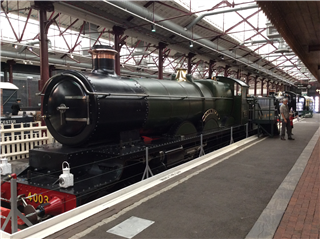The Great Western Railway 4000 or Star were a class of 4-cylinder 4-6-0 passenger steam locomotives designed by George Jackson Churchward for the Great Western Railway (GWR) in 1906 and introduced from early 1907. The prototype was built as a 4-4-2 Atlantic (but converted to 4-6-0 during 1909). They proved to be a successful design which handled the heaviest long-distance express trains, reaching top speeds of 90 mph, and established the design principles for GWR 4-cylinder classes over the next twenty-five years
During the first decade of the twentieth century, the new Chief Mechanical Engineer, George Jackson Churchward designed or acquired a number of experimental locomotives with different wheel arrangements and boiler designs to help him plan for the future needs of the railway. Following the success of his two-cylinder Saint class 4-6-0 locomotives, Churchward became interested in developing a more powerful 4-cylinder type for the longer non-stop express services. He therefore persuaded the GWR to acquire three French 4-cylinder 4-4-2 compound locomotives for comparison purposes.
In addition to acquiring the French compound locomotives Churchward built and tested his own prototype 4-cylinder locomotive simple-expansion locomotive, No. 40 North Star in 1906. In November 1909 it was converted to 4-6-0. The new design incorporated many ideas from the French locomotives, in particular, the four-cylinder layout, with the inside cylinders placed forward under the smokebox and the outside cylinders placed far back, in line with the rear wheels of the bogie; from this followed the divided drive with the outside cylinders connected to the second set of driving wheels whilst the inside cylinders were connected to the front set of driving wheels.
In total 73 locomotives were produced but only 1 has been preserved.
